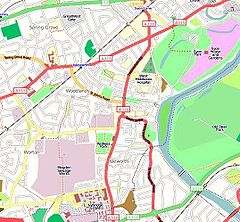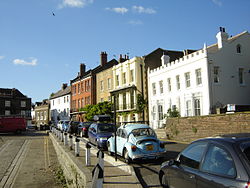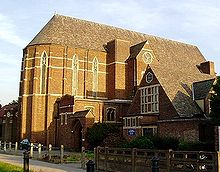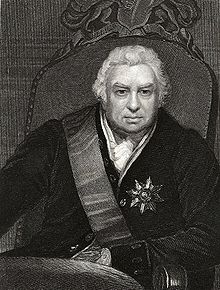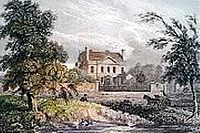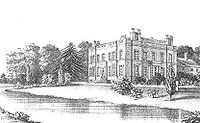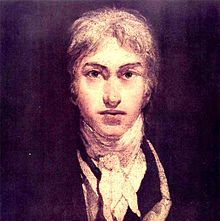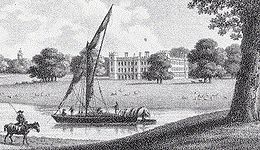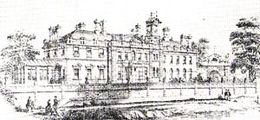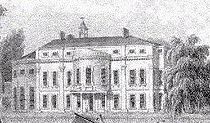- Isleworth
-
Coordinates: 51°28′00″N 0°20′11″W / 51.4666°N 0.3363°W
Isleworth
 Isleworth shown within Greater London
Isleworth shown within Greater LondonPopulation 20,500 OS grid reference TQ155755 London borough Hounslow Ceremonial county Greater London Region London Country England Sovereign state United Kingdom Post town ISLEWORTH Postcode district TW7 Dialling code 020 Police Metropolitan Fire London Ambulance London EU Parliament London UK Parliament Brentford & Isleworth London Assembly South West List of places: UK • England • London Isleworth (pronunciation: /ˈaɪzəlwɜrθ/) is a small town of Saxon origin sited within the London Borough of Hounslow in west London, England. It lies immediately east of the town of Hounslow and west of the River Thames and its tributary the River Crane. Isleworth's original area of settlement, alongside the Thames, is known as 'Old Isleworth'. The north-west corner of the town, bordering on Osterley to the north and Lampton to the west, is known as 'Spring Grove'.
Isleworth's former Thames frontage of approximately one mile, excluding that of the Syon estate, was reduced to little over half a mile in 1994 when a borough boundary realignment was effected in order to unite the district of St Margarets wholly within London Borough of Richmond upon Thames.[1] As a result, Isleworth's boundary with the Thames is now almost entirely overshadowed by the 3.5-hectare (8.6-acre) islet of Isleworth Ait.[2] The River Crane flows into the Thames south of the Ait, and its distributary the Duke of Northumberland's River west of the Ait.
Contents
Etymology
695 Gislheresuuyrth. From an Anglo-Saxon charter.
1086 Gistelesworde. The Domesday Survey
1301 Istelworth. Roll.
1415 Ystelworth. Roll.
Yhistelforth. George James Aungier, in 'History of Syon Monastery,
the Parish of Isleworth and the Chapelry of Hounslow, 1840.
Islleworth. Ditto
1540 Istyllworth. Local document
Istelworthe. An assize document in the reign of Elizabeth I
1554 Thyslyworth. Plea Roll, Court of Common Pleas.[3]
1593 Thistleworth or Gistelesworth. Norden and Lysons, historians.
1702 Istleworth. Shown on a memorial in the parish church.
1742 Isleworth. Title of an engraving by Thomas Preist.[4]History
Roman and Anglo Saxon
Excavations around the eastern end of the Syon Park estate have unearthed evidence of a Romano-British settlement. 'Gislheresuuyrth', meaning in Old English Enclosure belonging to [a man called] Gīslhere, is first referred to as a permanent settlement in an Anglo-Saxon charter in the year 695.[5] The Domesday Book says that during the reign (1042–1066) of Edward the Confessor the manor belonged to Earl Algar (Anglo-Saxon spelling probably Ælfgār), and a modern road off South St today carries his name.[6]
Granted to St Valeri Barons
Isleworth was a well established riverside settlement on the Middlesex bank of the River Thames at the time of the Norman Conquest in 1066. It is recorded in the Domesday Book (1086) as Gistelesworde.[7] After the Conquest, successive Norman barons of the St Valeri family held the manor of Isleworth but there is no evidence that they ever lived there - it being held only as a source of revenue and power. One of the later barons gave several manorial rents and privileges to the Hospital of St Giles. He also gave the church and advowson to the Abbey of St Valeri, which stood at the mouth of the Somme in Picardy.[8]
Transfer to Duchy of Cornwall
In 1227, when he took control of England from his regents, Henry III seized Isleworth and other property of the St Valeri family and gave the manor to his brother, Richard, 1st Earl of Cornwall. He built a new moated manor house, which is described in the Black Book of the Exchequer - having a tiled roof, chimney, two bedchambers, and an inner courtyard. Beyond the moat was an outer courtyard with a number of buildings for servants and supplies, and a short distance away was a watermill. The exact location of this house is not recorded, but a report of an area long ago known as 'Moated Place' puts the likely place between the Northumberland Arms and Twickenham Road, with the watermill being near Railshead, on the River Crane (not where the traditional Isleworth mill 'Kidd's Mill' was sited, because the stream there is artificial and did not exist at that time).[6] The seemingly classic mediæval manor house was burned down during the Second Barons' War in 1264.
Advowson of Isleworth Church
The Abbey of St Valeri in Picardy held the livings and revenues of several English parishes and, responding to growing disquiet over these foreign holdings, in 1391 it transferred those of Isleworth (for a fee) to William of Wykeham, who endowed them to Winchester College, which he founded. The Wardens and Scholars of Winchester College therefore became proprietors of Isleworth Church. This lasted for 150 years, then in 1543 King Henry VIII exchanged with Winchester certain manors elsewhere for five churches in Middlesex, including All Saints. Four years later he gave the Isleworth rectory and advowson to the Edward Seymour, 1st Duke of Somerset, but got them back again when the Duke was executed in 1552. Soon after, they were given to the Dean and Canons of St George's Chapel, Windsor, with whom they remain today.[9]
Transfer of Manor to Syon Monastery
In 1415 Henry V granted nuns from the Swedish Bridgettine order land on the bank of the Thames, in Twickenham parish opposite his new Sheen Palace, where they built their first house Syon Monastery. In 1422 Henry V transferred ownership of Isleworth Manor from the Duchy of Cornwall to Syon Monastery,[10] which in 1431 selected a new location within their manor to rebuild their monastery. This is the site of the present Syon House[11]
Granted to Duke of Somerset
Henry VIII demolished most of Syon Monastery after 1539 and the site and manor was granted to Edward Seymour, 1st Duke of Somerset. It was Seymour who built Syon House in 1548.
Acquired by Earl of Northumberland
Forty-six years later, in 1594 Queen Elizabeth I granted a lease of the manor of Syon to Henry Percy, 9th Earl of Northumberland on his marriage to Dorothy Devereux the younger daughter of Walter Devereux, 1st Earl of Essex, who later received a grant of the freehold from King James I in 1604.[12] It has remained in the possession of the Percy family, now the Dukedom of Northumberland, for over four hundred years. The Royalist army occupied the house during the Battle of Brentford in November 1642. Syon Park was rebuilt and landscaped by the Adam brothers and "Capability" Brown between 1766 and 1773. It became the new London home of the Dukes of Northumberland when Northumberland House in the Strand was demolished in 1874.
Georgian / Victorian
Much of Isleworth became orchards in the 18th century, and then market gardens in the 19th century, supplying the London markets. Lower Square and Church Street still have buildings dating from the 18th and early-19th centuries. A striking element of this period was the establishment in Isleworth of many mansions and large houses, principally for aristocrats and high achievers. This phenomenon arose owing mainly to the collection of royal and noble residences and ecclesiastical establishments that already existed nearby. The subject is examined in depth further down this article
20th Century
The first half of the twentieth century for Isleworth generally was characterised by a very substantial amount of artisan and white-collar residential development throughout the town, at the expense of numerous market gardens. This was accompanied by the building of several new factories and offices, mostly towards the north-east, up to the town boundary of the River Brent. This rapid spread of building transformed the nature of Isleworth's layout in the space of just fifty years, from an agrarian pattern to an urban one. When the postwar recovery period had passed, development resumed in the 1950s and within fifteen years the town of Isleworth and the county of Middlesex gave way to the inexorable expansion of London.
Further reading
"A History of the Urban Districts of Heston and Isleworth" (Gill and Sons, London).
Amenities
Isleworth is home to a crown court whose original remit has been expanded to include judicial work formerly conducted at the Middlesex Guildhall, involving the addition of six courtrooms and twenty two cells.
The town's municipal facilities include a public library, a public leisure centre with swimming pool, a gymnasium, four recreation grounds, and a town hall.
There used to be a film studios located in Worton Road, Isleworth. Known variously as Worton Hall Studios and Isleworth Studios, its most notable movie was The African Queen starring Humphrey Bogart and Katharine Hepburn. After the Studios closed, the premises became a Mining Research Establishment for the National Coal Board. It is now an industrial estate.
The Boat Cathja is moored in Old Isleworth. This is a unique 38 meter barge which has been the home of a mental health charity since 1996. It helps mentally disabled people a chance to hone into their artistic skills. Situated on the boat is the Sculpture "The Heron" by Martin Cotts.[13]
Hospitals
Brentford Workhouse Infirmary and West Middlesex Hospital (History)
The Brentford Poor Law Union had a workhouse built in 1838, on land to the east of Twickenham Road in Isleworth. At the turn of the twentieth century this was totally rebuilt as an infirmary, with a much larger workhouse newly erected nearby.[14] This infirmary functioned until 1920, when it became 'West Middlesex Hospital'. In 1931 it was upgraded to a county hospital, but in 1948 (under the NHS) 'County' was dropped from its title. It later became a teaching hospital, and added 'University; to its title in 1980.[15]
West Middlesex University Hospital (NHS Trust)
This is a major acute hospital on the Twickenham Road, Isleworth, with 394 beds, providing the full range of services expected of a general hospital. It serves residents of both the London boroughs of Hounslow and Richmond. As a university hospital it is affiliated with Imperial College London. A programme of building, renovation and modernisation in recent years has resulted in the hospital offering superb, modern facilities.
Percy House Military Hospital (History)
Within the old union workhouse complex stood a school, facing Twickenham Road, called Percy House - Percy being the surname of the Duke of Northumberland. Owing to its gradual disuse as a school it was adapted to function as a military hospital during World War I of 1914-18. From 1915 onwards it treated some 5,000 war-wounded soldiers, and then ceased operation some time after the war's end. The building was demolished in 1978.[14]
Mogden Isolation Hospital (History)
For nearly a hundred years an isolation hospital existed on the south side of Mogden Lane, which runs west from Twickenham Road. Opened in 1897, Mogden Isolation Hospital served its own borough and that of Richmond, retaining its name until 1938. It was then renamed 'South Middlesex Fever Hospital' but continued under local authority control. When the National Health Service was formed it became, in 1948, simply 'South Middlesex Hospital' - still dealing with acute and infectious diseases under the North West Metropolitan Regional Hospital Board. Then from 1974 until its closure in 1991 it was administered by the North West Thames Regional Health Authority.[16]
College
Schools
Primary
- The Blue School CE
- Isleworth Town
- Ivybridge
- Marlborough
- Smallberry Green
- Spring Grove Primary
- St Mary's RC
- Worple
Secondary
- The Green School for Girls
- Gumley House Convent RC School for Girls.
- Isleworth & Syon School for Boys
- Oaklands School (SEN)
Churches
All Saints Church, which faces the River Thames at the eastern end of Church Street, is the parish church of Isleworth. It dates from the 14th century and its tower has endured fire and the passage of time to survive to the present day. By the end of the 17th century it was in need of repair and Christopher Wren, who, as well as rebuilding St Paul’s Cathedral, had repaired many London churches, was approached to submit a plan for the building. His project was deemed too expensive until 1705, when Sir Orlando Gee died and left £500 towards the work. This sum, combined with funds raised through subscriptions, meant that the work, with a few modifications, could commence and was finished in 1706. In 1943 a fire started by two school boys, who a few days later set fire to Holy Trinity Church in Hounslow, destroyed much of the building. The present church was built in 1970 to replace an earlier church building incorporating the original 14th century stone tower.
St Francis of Assisi Church
St Bridget RC Church
St John's Church, St John's Road, Isleworth, Middlesex, TW7 6NY.
St Mary's Church, Osterley Road, Isleworth, TW7 4PW.
St Mary the Virgin Church, Worton Road, Isleworth.
Isleworth Congregational Church, Twickenham Road, Isleworth, TW7 7EU.
Transport
Routes
The principal road in Isleworth is the London Road (A 315), which broadly follows the route of one of the early roads the Romans constructed in Britannia, namely Tamesis Street, built across the wide heathlands en route to Silchester, from where other roads led to Bath, Winchester and Salisbury.[17]
As this road from the centre of London passes through Westminster it is called 'Piccadilly' and then 'Knightsbridge'. In Kensington it is 'High Street', in Hammersmith 'King Street', in Chiswick it's the 'High Road', in Brentford it's the 'High Street', and as Isleworth's 'London Road' passes into Hounslow it again becomes 'High Street'. In former times it was part of the 'King's Highway' to Windsor.
A bigger road was completed in 1925, named the Great West Road (A 4), moving in much the same direction and forming the notional northern boundary of Isleworth. A six-lane dual carriageway for most of its length, with attendant cycle paths, it fulfilled the purpose of bypassing the bottlenecks of Brentford and Hounslow high streets to relieve the old road from London of traffic heading to and from Windsor and beyond. A later branch extension off this new road, named the Great South West Road, carried traffic south-westwards and this had the additional effect of relieving the London Road of traffic heading to and from Staines and beyond. In terms of volume and speed of traffic the newer road is of course a much more important throughway for Isleworth, but in human terms it does not identify with or serve the local community so closely.
The other throughway in this category is the Twickenham Road (A 310), which branches off London Road west of the Syon estate and takes traffic to Twickenham, Teddington and beyond. This was the King's Highway to Hampton Court, so in years past those houses fronting on Twickenham Road, such as Somerset House, Kendal House and the two Silver Halls would have been favoured with a royal gaze from time to time.
Road passenger services
Isleworth had a tram depot situated on the north side of London Road, near to the border with Hounslow. The original operating company was London United Tramways. After the formation of the London Transport Passenger Board the depot was converted in 1935 to trolleybus operation. Its construction was designed in a horseshoe shape with a travelator (which also incorporated a turntable) at the far end. Originally known as Hounslow Depot, it was renamed Isleworth and given the code "IH" in trolleybus days. It had a capacity for a maximum of 37 vehicles and only ever operated on one service - namely the 57 tram route which, on conversion, became the 657 trolleybus route. Both the 57 and 657 services operated between Hounslow Heath & Shepherd's Bush Green via Hounslow Town, Isleworth, Brentford, Chiswick, and Goldhawk Road. The Hounslow terminus was, in the case of the 57 tram, from a tramway stub near the Hussar Pub and in the case of the 657 trolleybus, on a turning place at the junction of Staines Road & Wellington Road. At different times there were ambitious plans to extend the tram lines westward to Staines and even to Maidenhead, but these never came about and even the modern replacement motor bus routes still only mainly traverse the original roads.
When the 657 figured in the final London trolleybus conversion of all, on May 8, 1962, Isleworth Depot closed and its replacement motor buses and staff were transferred to nearby Hounslow Bus Garage. The service number for the route became 117, which up to this time ran between Egham and Hounslow.The 117 was later superseded by extensions to the then 237 route. Hounslow Garage became part of the Transdev London London United operation and this, in turn, has been taken over by RATP Group which is another French owned company.
There was also the 667 trolleybus, formerly the 67 tram, which passed through Isleworth en route from Hampton Court to Hammersmith via Hampton Hill, Fulwell, Twickenham, Busch Corner, Brentford and Chiswick. Upon its transfer to motor bus operation, as part of the final London trolleybus conversions, the route had its number changed from 667 to 267. Both the 667 and its replacement have been operated by Fulwell Garage. The history of the ownership of Fulwell (coded "FW") is exactly as for Hounslow Garage above.
On Summer Bank Holidays both the 657 and the 667 operated extra scheduled journeys whereby they exchanged their termini, with some 667s operating to Shepherds Bush and some 657s operating to Hampton Court. This practice did not survive after the trolleys were withdrawn.
A long-established motor bus route serving Isleworth (and Hounslow) was the number 37. This was one of the earliest motor bus routes introduced by the London General Omnibus Company and it originally ran from Isleworth to Peckham via St Margarets, Richmond, Barnes, Putney, Wandsworth, Clapham Junction, Clapham Common, Brixton, Herne Hill and East Dulwich. It was later extended westward to Hounslow (passing Isleworth railway station) and for a brief time offered a summer service extending as far as Maidenhead. Even without that short-lived extension the 37 was one of London's longest routes. At first the terminus in Isleworth was actually the forecourt of The Northumberland Arms public house. Later, for "short" running timings, this changed to stands in Magdala Road and then in South Street, outside the Public Hall. The western arm of this historic route was curtailed between Putney and Hounslow in 1991 and the section between Richmond and Hounslow via Isleworth became the province of a new, more localised service numbered H37.
As of September 2011 the bus services serving Isleworth and provided by Transport for London are: 117, 235, 237, 267, 481, H20, H22, H28, H37, H91, N9.
Rail passenger services
Isleworth has only one rail service. It consists of a loop branch line running off the minor main line service operated by South West Trains between central London and Reading. On the down-service the loop begins at the Barnes junction, then travels through the towns of Chiswick and Brentford before entering Isleworth by crossing over the River Brent just south of the A4 trunk road. Thereafter it serves the two stations of Syon Lane and Isleworth before leaving the town just north of the Woodlands estate and passing under Bridge Road. The service usually runs at fifteen minute intervals. Following its next stop at Hounslow the loop re-enters the main line on the up-service shortly before the Whitton station.
Nearest National Rail stations
Nearest London Underground stations
- Osterley Piccadilly Line
- Hounslow East Piccadilly Line
- Richmond District Line
River passenger services (history)
1840 George J Aungier: "There is a ferry, called Church Ferry, for foot passengers, from the church over the river to West Sheen, Kew, &c. and another at the southern extremity of the village, called Rails-head Ferry."[18]
1947 Rails-head Ferry still existed, more than fifty years after the nearby footbridge had been built.
1952 Typical pleasure boat of the mid-20th century seen here from Isleworth Promenade.
Residents
Notable residents
- Peter Oliver (1594–1648), watercolour copyist and miniature portrait artist, lived in his native Isleworth. He painted many figures at the courts of Kings James I and Charles I.
- In 1779 Sir Joseph Banks, England's greatest botanist, took a lease on, and eventually bought, a house with thirty-four acres (13.76 ha) along the northern side of what is now London Road. It became known as 'Spring Grove House'. Although he also had a home in central London he spent much time and effort on his Isleworth property. He steadily created a renowned botanical masterpiece on the estate, achieved primarily with many of the great variety of foreign plants he had collected on his great travels around the world, particularly with Captain Cook to Australia and the South Seas. Banks died in 1820, and over the next thirty years the house was considerably modified and enlarged by a new owner, Henry Pownall, who then sold the estate in 1850 for partial redevelopment.
The images on the right show the house as it looked in 1810, and then in 1850.
- In 1804, William Turner lived for a short time in Sion Ferry House in Isleworth, where he drew inspiration from the picturesque banks of the River Thames. His paintings thereafter include the Houses of Parliament and Hampton Court from the Thames.
- Ian Gilmour, who became 3rd Baronet of Craigmillar, was Secretary of State for Defence and Lord Privy Seal during the 1970s. He lived at the current Ferry House, on the same site as above, for fifty-three years until his death in 2007.[19]
- Post-impressionist artist Ian Riches moved to Isleworth in 1876 to become a teacher and assistant preacher at a local school. A blue plaque exists on the house he lived in alongside Twickenham Road.
- Andrew Pears was the third generation head of the Pears Soap business located in Isleworth and in 1886 he bought Spring Grove House (mentioned above). He rebuilt it in 1892/94 on a grander scale, retaining the structure, facing the building with new red brickwork, and adding large rear extensions. This created a sizeable mansion, most of which still stands. The house is now part of West Thames College.
- Walter R. Booth (1882–1938) creator of the first British animated cartoon film, The Hand of the Artist, constructed his own outdoor studio in the back garden of Neville Lodge, Woodlands Road, Isleworth in 1906 with Harold Bastick as his cameraman. At least fifteen films a year were made up to 1915, after which he entered the publicity film market, making advertising shorts for Cadbury.
- Arthur Penty (1875–1937) an architect and writer on guild socialism and distributism lived in Church Street, Old Isleworth (1926–1937). He is commemorated by a blue plaque.
- Eileen Sheridan, a supreme champion English cyclist of the 1940s & 1950s, lived in Church Street, Old Isleworth for many years.
- Ronald Chetwynd-Hayes (1919–2001) was born in Isleworth. For over 30 years, R. Chetwynd-Hayes published more than 200 Short Stories, 8 novels, and over 20 Collections - as well as editing 24 anthologies including many of the Fontana Ghost Stories series of anthologies.
- Actor William Hartnell, best known as The First Doctor in Doctor Who from 1963-1966, lived opposite the London Apprentice pub during the 1960s, next door to the art collector Hugh Blaker.
- Presenter Fiona Phillips lives in Isleworth.
- Author Ellen Edith Hannah Redknap (1906–1991) lived at Worton Way and wrote under the name of Erroll Collins. She was active during the 1940s, specialising in adventure and science fiction for boys.
Grand houses of the past
A period of intense mansion-building occurred in the 18th and 19th centuries. There was a triple attraction to the area in those times. Its rural, waterside beauty had become well recognised over two hundred years or so, and a few palaces, monasteries and mansions already existed. Then the royal court began to appear at Kew, so the adjacent districts on both sides of the Thames became very fashionable places for the rich and famous to build their grand homes. Some of the cachet dropped away when the court eventually left Kew, but the inherent residential desirability of the area remained for many more years.
- Syon House Duke of Somerset Duke of Northumberland. (standing, listed Grade 1)
- Although this grand house has had a close connection with Isleworth for 450 years, its renown as the only ducal seat within London is so great and its attributes so well chronicled elsewhere that this article is not the place to add anything further.
 Silver Hall in 1800, on the King's Highway to Teddington.
Silver Hall in 1800, on the King's Highway to Teddington.
- Silver Hall No. 1 (South of North Street, with four acres) [1.6 hectares] Sir John Smith Bt, Privy to William & Mary Lady Harcourt, widow of Sir W Harcourt, Chancellor (Demolished 1801[20][21] →
- Silver Hall No. 2 (North of North Street) Joseph Dixon. (Demolished 1950)[21]
- Kendal House (Twickenham Road, near Mill Plat) Duchess of Kendal (mistress to George I).[22]
 Somerset House in 1800
Somerset House in 1800
- Somerset House
←
- Gunnersbury House (At the junction of Bridge Road and London Road) (Demolished c.1972).[23]
- Isleworth House Sir William Cooper, chaplain to George III.[20] Renamed Nazareth House in 1892.[23] (standing)
- Countess of Charleville's Villa Harriet Charlotte Beaujolais (Campbell), Countess of Charleville.
- Wyke House
 Little Syon in 1802 (Built 1592)
Little Syon in 1802 (Built 1592)
- Little Syon (formerly Cromwell House) Sir Richard Wynn Bt. (Demolished 1818).[20]
←
 Gumley House in 1800
Gumley House in 1800
- Gumley House John Gumley (Commissary-General to the Army) The Earl of Bath (Gumley's son-in-law) General Lord Lake.[21]
→
- Shrewsbury House George Talbot, 14th Earl of Shrewsbury
Shrewsbury House lay to the east of Upper Square, in the area known as Lion Wharf, once Beck's Wharf, also Shrewsbury Wharf. The 14th Earl inherited the lease in 1719 and later by Act of Parliament gained full rights to the property (in exchange for certain fee-farm rents) from an almshouse charity established by a former landlord, Sir Thomas Ingram, from whom the 1st Duke of Shrewsbury had originally leased the site. Around 1778 the 14th Earl started the process by which the house converted to a school for boys of Roman Catholic parents.[24][25]
- Gordon House, by the River Thames at Railshead Rd. (standing, listed Grade II*) →
- General Humphrey Bland Lord James Hay Lord John Kennedy-Erskine
Lord and Lady Frederick Gordon Earl of Kilmorey Judge T C Haliburton MP.
- In Lord Hay's time this was named 'Seaton House', after his ancestral home in Aberdeenshire. It was next bought by King William IV at 8,000 guineas for his (illegitimate) daughter Lady Augusta, who married Lord John Kennedy-Erskine of Dun, the son of the First Marquis of Ailsa who lived next door in St Margaret's House. Gordon House is being renovated.[20][26][27][28]
- Spring Grove House Sir Joseph Banks Andrew Pears.[20] (standing, Grade II)
- In 1862 Francis Pears decided to expand his soap making business and bought land alongside the London Road for a factory. Another, larger, factory was opened along the opposite side of the road in the 1880s and soap was made on the site until 1962. His son Andrew bought the Spring Grove House estate in 1886 and greatly extended the house in 1894. Pictures are shown under 'Notable residents'.
- Keppel House First Lord of the Admiralty Augustus Keppel .
- Lacy House A 17th Century house rebuilt in 1750 for James Lacy, of Drury Lane Theatre.
Lacy's son inherited the property but his extravagance compelled him to sell the house, to the Hon. Sir Edward Walpole K.B. He bequeathed it to his daughter, widow of Bishop of Exeter, and after that it was acquired by the Earl of Warwick. After him came the famous playwright Richard Sheridan, who by then had already produced his two masterpieces School for Scandal and The Rivals. Lacy House was demolished in the 1830s.[20][29] - St Margaret's House (Lacy House rebuilt and renamed) First Marquis of Ailsa.[20]
- Kilmorey House (replaced St Margarets House in 1853). Built for 2nd Earl of Kilmorey but never lived in. Became the Royal Naval School for Girls (1856–1940).[20] (Demolished 1950).
Adjacent towns or districts
Destinations from Isleworth 
Heston Osterley Brentford 
Hounslow 
Richmond  Isleworth
Isleworth 

Whitton Twickenham St Margarets References
- ^ The Greater London and Surrey (County and London Borough Boundaries) (No.4) Order 1993
- ^ "Isleworth Ait". London Wildlife Trust. 2007. http://lwt.elmbrook.eu/NatureReserves/IsleworthAit/tabid/136/Default.aspx. Retrieved 26 December 2010.
- ^ http://aalt.law.uh.edu/AALT3/M/CP40no1157/aCP40no1157fronts/IMG_1355.htm
- ^ Collage
- ^ Thames Landscape Strategy | The Arcadian River Thames between Hampton and Kew | tlsdocument
- ^ a b 'And So Make a City Here' by G E Bate F.R.Hist.S. p68 published: Thomasons Hounslow 1948
- ^ Mills, A. D. (1996). Dictionary of English Place-Names, p.188. Oxford University Press, Oxford. ISBN 0-19-283131-3.
- ^ 'And So Make a City Here' by G E Bate F.R.Hist.S. p68 publisher: Thomasons, Hounslow 1948
- ^ 'And So Make a City Here' by G E Bate F.R.Hist.S. pp106/7 published: Thomasons Hounslow 1948
- ^ Aungier, p.39; Rot. Parl. 9 Hen V, p.1,m.7
- ^ Aungier, G.J. History and Antiquities of Syon Monastery, London, 1840
- ^ Victoria County History, A History of the Co. of Middlesex, Vol.3, Syon House, pp.97-98
- ^ cathja.org
- ^ a b The Workhouse - www.workhouses.org.uk
- ^ The National Archives | Search the archives | Hospital Records| Details
- ^ The National Archives | Search the archives | Hospital Records| Details
- ^ 'And So Make a City Here' by G E Bate F.R.Hist.S. p355 publisher: Thomasons, Hounslow 1948
- ^ The history and antiquities of Syon ... - Google Books
- ^ Alexander, Lucy (15 August 2008). "The late Tory MP Sir Ian Gilmours London home is for sale". The Times (London). http://property.timesonline.co.uk/tol/life_and_style/property/buying_and_selling/article4530565.ece.
- ^ a b c d e f g h Heston and Isleworth - Introduction | British History Online
- ^ a b c 'And So Make a City Here' by G E Bate F.R.Hist.S. p121 published: Thomasons Hounslow 1948
- ^ Isleworth | British History Online
- ^ a b [1][dead link]
- ^ Heston and Isleworth - Roman catholicism | British History Online
- ^ 'And So Make a City Here' by G E Bate F.R.Hist.S. p118 published: Thomasons Hounslow 1948
- ^ 'And So Make a City Here' by G E Bate F.R.Hist.S. p261 published: Thomasons Hounslow 1948
- ^ The Laird o' Thistle
- ^ "Strictly ballroom". The Times (London). 4 March 2007. http://property.timesonline.co.uk/tol/life_and_style/property/buying_and_selling/article1457225.ece.
- ^ 'And So Make a City Here' by G E Bate F.R.Hist.S. p262 published: Thomasons Hounslow 1948
External links
- Hounslow Council
- The Isleworth Society
- Isleworth links on British History Online
- Isleworth St John's Residents' Association
List of places in London Major districts Abbey Wood · Acton · Barking · Barnes · Barnet · Barnsbury · Battersea · Beckenham · Bermondsey · Bethnal Green · Bexleyheath · Bloomsbury · Bow · Brentford · Brixton · Brockley · Bromley · Camberwell · Camden Town · Canonbury · Carshalton · Catford · Charlton · Chelsea · Chessington · Chingford · Chislehurst · Chiswick · City · Clapham · Clerkenwell · Cricklewood · Coulsdon · Croydon · Dagenham · Deptford · Ealing · East Ham · Edmonton · Eltham · Enfield Town · Erith · Feltham · Finchley · Forest Hill · Forest Gate · Fulham · Greenwich · Hackney · Hammersmith · Hampstead · Harrow · Hendon · Highams Park · Highbury · Highgate · Hillingdon · Holborn · Hook · Holloway · Hornchurch · Hounslow · Ilford · Isle of Dogs · Isleworth · Islington · Kensington · Kentish Town · Kensal Green · Kilburn · Kingston upon Thames · Lambeth · Lewisham · Leyton · Marylebone · Mayfair · Mitcham · Morden · Muswell Hill · New Cross · New Malden · Orpington · Paddington · Peckham · Penge · Pinner · Poplar · Purley · Putney · Richmond · Romford · Ruislip · Shepherd's Bush · Shoreditch · Sidcup · Soho · Southall · Southgate · South Norwood · Southwark · Stepney · Stoke Newington · Stratford · Streatham · Surbiton · Sutton · Sydenham · Teddington · Thamesmead · Tolworth · Tooting · Tottenham · Twickenham · Upminster · Upper Clapton · Uxbridge · Walthamstow · Wandsworth · Wanstead · Wapping · Wealdstone · Welling · Wembley · West Ham · Westminster · West Norwood · Whitechapel · Willesden · Wimbledon · Wood Green · Woodford · Woolwich
Barking and Dagenham · Barnet · Bexley · Brent · Bromley · Camden · Croydon · Ealing · Enfield · Greenwich · Hackney · Hammersmith and Fulham · Haringey · Harrow · Havering · Hillingdon · Hounslow · Islington · Kensington and Chelsea · Kingston · Lambeth · Lewisham · Merton · Newham · Redbridge · Richmond · Southwark · Sutton · Tower Hamlets · Waltham Forest · Wandsworth · Westminster
Categories:- Districts of London
- Districts of Hounslow
- Districts of London on the River Thames
- Districts of London listed in the Domesday Book
Wikimedia Foundation. 2010.


